What is a self-adhesive film and what is it like?

Currently, the range of various coatings is huge. So, a very popular option is a special self-adhesive film, which is divided into several types. In this article, we will take a closer look at this material and find out how it happens.


Description and purpose
First, you need to figure out what a self-adhesive film is. It is a material that boasts virtually unlimited application possibilities. It is used in many areas. High-quality film can also be used in all sorts of design ideas. Most of the products are environmentally friendly and safe, durable and inexpensive. Such distinctive features have always attracted the buyer.


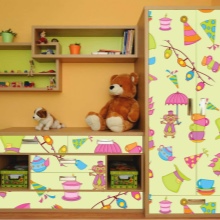
The material in question is also distinguished by its waterproof structure. It can be safely used in rooms where there is a high humidity level. High temperatures of self-adhesive paper are not terrible. A high-quality coating can withstand temperatures as low as 80 degrees Celsius without any problems.
Self-adhesive is made using a special technology. For example, coatings designed specifically for finishing furniture structures consist of several layers.
- External. In most cases it is made from PVC, polyester or propylene. Vinyl is the most commonly used film. These are affordable options that boast a long service life.
- Kleeva. An obligatory layer of the material in question. Required in order for the film to be successfully adhered to the selected substrate. Before finishing this or that surface with self-adhesive, it must be properly prepared.
- Protective. This layer covers the adhesive part of the film until it is glued to the selected place. The protective cover must be removed only before the start of the planned work.



Self-adhesive paper is available in a wide range. Consumers can find coatings in a wide variety of colors in the store. Very popular and attractive specimens imitating natural stone, marble, wood and other expensive materials. The film can also be decorated with a variety of prints and patterns. There are even mirror modifications that look especially original and stylish.
High-quality self-adhesive film of modern production can be easily and quickly glued to the following materials:
- natural wood;
- chipboard (chipboard);
- glass;
- metal;
- polyvinyl chloride;
- drywall (gypsum plasterboard).


Nowadays, self-adhesive films of different colors are most often used to update the appearance of various coatings.
For example, it could be old furniture or some home decor that needs a refreshing design. Fortunately, the use of films is very simple, they easily fit on all materials (listed above), from which modern furniture is made. Properly selected self-adhesive paper can "refresh" almost any environment.


Species overview
As mentioned above, self-adhesive foil comes in many different options. Each type has its own distinctive features and characteristics that must be considered before use. Films are divided according to different criteria. Let's take a look at some of them.



By appointment
A high-quality and correctly selected film can be used both inside and outside the home. Let's take a closer look at what this unpretentious and aesthetic material is most often used for.
- Toilet, bathroom. The film can be an excellent solution for protecting walls from water and soap splashes, detergents. Subsequently, smudges will not remain on such a decorative coating, which indicates its unpretentiousness and extremely simple care.
Also, self-adhesive film prevents the appearance and spread of mold, which is very important for rooms with high humidity.

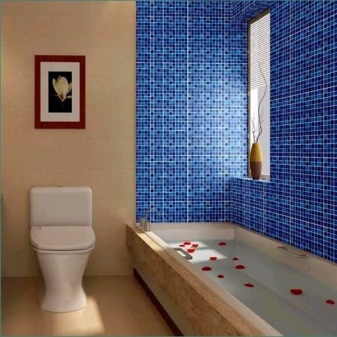
- Children's room. Kids often paint boldly on furniture, walls, and any other surface. It can be very difficult to erase paint and felt-tip pens from the wallpaper, often the finish from washing begins to deteriorate and lose its former attractiveness. The solution to this problem will be the sizing of "vulnerable" areas in the room with tape. After careful drawing with a children's pen, such material can be easily replaced with a new one, because such a cosmetic repair will cost a very small amount.

- Living room, bedroom, hallway. The film can also be glued in these rooms. Most often, the material in question is used here for application to old furniture, doors, window structures. Self-adhesive will not allow the paint to crack, simplify the procedure for caring for window sills.



Self-adhesive material is often used not to protect one or another base, but only to decorate it.
For such purposes, the most attractive decorative film is selected. It can be glued to wallpaper or other interior details. With such a component, the atmosphere can sparkle with new colors.



In many cases, the film in question is used for kitchens. With the help of such a material, not only are various surfaces protected from greasy stains and hot steam, but also old furniture structures are decorated. For example, self-adhesive and heat-resistant coatings are found with an enviable frequency in the apron area in the kitchen. This is the kind of workspace that especially needs additional protection from contamination.

Besides, a bright and beautiful apron can be an interesting interior decoration. For such purposes, a well-chosen and attractive self-adhesive film is best suited. But these coatings are used not only for furniture and walls in the home, but also for the floor or ceiling. For such bases, special types of films are selected, especially when it comes to flooring. Most often they are used for original and inexpensive decoration of the existing space.


By surface type
Self-adhesive films produced today are subdivided not only by their direct application, but also by the type of surface. This is another important criterion that the consumer must take into account before choosing such a product. Let's consider in detail what types of self-adhesive films with different surfaces are sold today.
- Glossy. Films with such a coating are among the most popular and widely used. They are sold in many stores. The coverings in question adhere very easily to various substrates, giving them a more attractive, updated appearance. In addition, the aesthetic glossy shine looks very good in modern interiors. These films are an excellent solution for those rooms where there is a lack of natural light.
It is advisable to glue the film in the rooms located on the north side.


- Matt. There are also matte laminating films. They look neat and stylish. The application does not require complex manipulations or special knowledge.
Matte types of films are best suited for fairly spacious rooms with a lot of light.


- Holographic. The complete opposite of classic self-adhesive clear laminates. A holographic coating can easily simulate a three-dimensional pattern. Often, these items are sold in bright, radiant colors that attract a lot of attention.


- Transparent. The simplest types of self-adhesive films. They are used to protect certain surfaces from all sorts of mechanical damage - chips, scratches.


- Velvet. New textured films that successfully imitate fabrics of different types are very popular today. The most interesting are velvet specimens and coverings that imitate velor. Such products will not only decorate the interior, but also bring notes of calmness and comfort to it. Most often they are used in a bedroom or living room - here they look as harmonious as possible.


- Photo printing. Modern self-adhesive films look no less interesting, on the surface of which various pictures are depicted, applied using the technique of photo printing. It can also be canvases in rolls on which there are 3D drawings. If you want to bring original and creative notes to the interior, these options are perfect.
The main thing is not to overdo it with such films, so that the interior does not seem overloaded.


- Mirror. Very effective films, they attract a lot of attention. Suitable for small rooms where they can visually expand the available space. Mirror films are more common in the kitchen or bathroom.

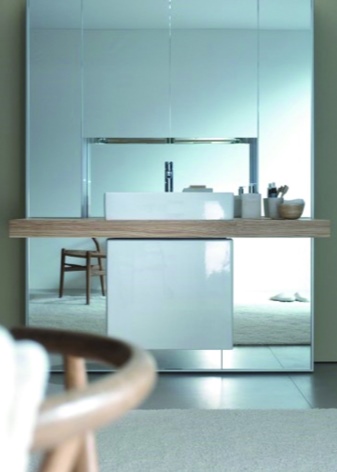
Materials (edit)
When choosing a high-quality self-adhesive, it is very important to pay attention to what specific material it is made of. On sale there are coatings based on different raw materials. This will certainly affect the performance of the finished product.
Today, films made from:
- propylene;
- polyester;
- polyvinyl chloride (PVC).



Based on the material underlying the film, it can be single-sided or double-sided. There is also a special thick aluminum type of self-adhesive.
It is made of aluminum foil using a special technology.


Color palette and design
It was already mentioned above that modern self-adhesive films are presented in a wide range. Buyers can choose from a variety of colors. Among a large selection of scales and palettes, you can find the best option for any purpose and interiors. Let's take a closer look at which films are the most popular, and in which design ensembles they look especially harmonious.
- White. The classic color fits well in almost all interiors and environments. The fact is that snow-white shades easily "get along" in the neighborhood with most flowers. For example, a kitchen set can be decorated with such material, and it will look very light and elegant.

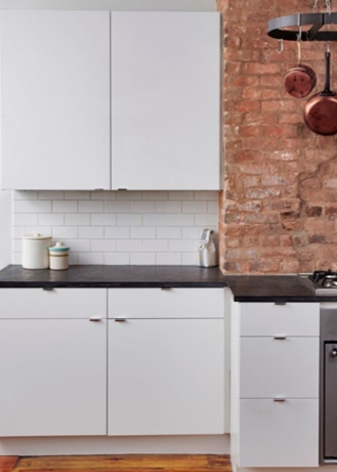
- Black. Black film also works well in different settings, but it shouldn't be too much. You can paste over an accent wall in a light interior using a dark film with a matte texture. The ensemble will look stylish and modern.

- Marbled. Films imitating marble are incredibly popular. A high-quality and well-made coating can "refresh" the interior, effectively decorate it. You can also paste over a kitchen set with a similar film, and it will look very presentable.


- Under the brick. Correctly used interior film for brick will become an original detail in many rooms. Most often, such coatings are used in loft-style interiors. For example, you can paste over the niches located behind the gray sofa with a film under the brick.

- Gray. Gray self-adhesive is universal.It can be used to update a variety of furniture such as dressers and wardrobes. True, it is advisable to dilute the gray color with other shades so that it does not make the object too boring.

- Yellow. If there are not enough bright colors, it is advisable to use a yellow colored film. It can be glued to various furniture designs that you want to give more rich and rich colors. Only after that, it is advisable to reinforce the yellow film with something else, for example, a vase with yellow flowers.


- Wenge. Popular and trendy shade. It looks aesthetically pleasing, solid. Currently, wenge is a popular color used in the manufacture of various furniture. For example, to give a kitchen set in a light room a more presentable appearance, you can use a film of the specified shade.

- Green. The green film looks interesting. It can be used to paste over kitchen countertops or cabinet doors.
Green "feels great" against the background of other calm colors, but contrasting combinations are not prohibited either.


- Under the metal. Today, coatings are very popular not only for stone, but also with a metallic surface. Metallic film will look gorgeous in a modern or futuristic interior.


- Under the skin. The coatings, pasted over with a film imitating leather of different shades, look unusual and stylish. True, with such textures it is also better to observe moderation, otherwise they will seem cheap and ridiculous.


- Gold and silver. Gold and silver films look bright and expressive. These colors look especially good with a more neutral and relaxed neighborhood. It is better to avoid an excessive riot of colors here.


- Orange. Suitable for interiors that lack rich colors. This color scheme looks best on a light and monochromatic background, for example, white or light beige.


- Blue. A blue film looks calming, aesthetically pleasing and attractive in the interior. There are many different shades of blue - the right option can be found for any ensemble. The moisture-resistant film of the color in question looks good both on kitchen furniture and on the bases in the bathroom.

How to choose?
A high-quality self-adhesive film must be chosen deliberately so as not to be mistaken with a purchase. Let's consider what is worth paying attention to.
- First, you need to decide what type of self-adhesive you need. Choose from matte, glossy, glossy or transparent options. Decide on the purpose of your future purchase. So, if the film is needed only as a protective layer, then the usual transparent version will do. If we are talking about a beautiful decor, you can choose a coating with a pattern, beautiful prints or color tints.


- Self-adhesive film must be made from quality raw materials. Most often, polyvinyl chloride copies are found, which are of very good quality.

- Decide on the volume of the selected material. The film must have the optimum dimensions in width and height. In order not to be mistaken in this, you should first measure the base that you planned to paste over with a new self-adhesive.
It is recommended to purchase a film with at least a small margin, so as not to face a shortage of material.


- Find the perfect film design. The color, texture or print of the coating should harmoniously fit into the existing interior, complement it. If the design of the film does not suit the situation, then its general appearance will seem disharmonious and even ridiculous.


- It is recommended to buy self-adhesive films from reputable manufacturers. As a rule, even branded coatings are inexpensive, so there is no need to be afraid of exorbitant prices. A wide range of branded products can be found in specialized outlets or building materials stores.
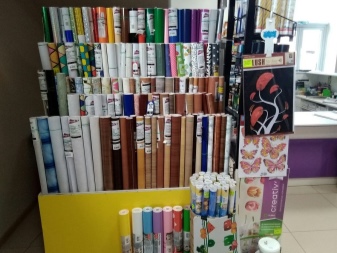

- Examine the plastic wrap. In no case must it be damaged or defective.The goods must be clean, not wrinkled, without torn areas or poorly protected areas.

How to stick it correctly?
Modern adhesive coatings can be applied to any surface extremely simply and quickly. You just need to adhere to a certain sequence of actions. Let's consider which ones.
For the gluing process you will need:
- ruler;
- pencil;
- scissors or a sharp knife;
- putty knife;
- clean cloth;
- needle.
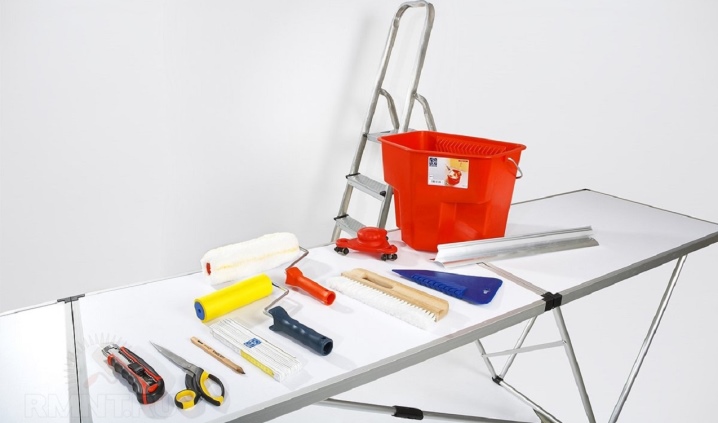
Let's consider how the correct gluing of the film takes place using the example of furniture design.
- If the surface is small, for example, the front of the cabinet, then the film can be glued "dry".


- Larger bases must be pre-moistened with water, soapy water.


- All accessories must be removed.


- You need to start gluing the film from above. It is necessary to separate about 8-10 cm of the film from the base and attach the sticky side to the upper zone of the furniture.
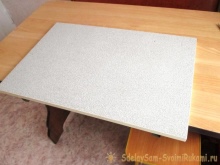


- The section is well fixed and carefully smoothed with a cloth. Movements should be done from the center to the edges in order to expel air bubbles.


- Then you will need to carefully separate the rest of the film from the protective coating, going down the furniture structure.


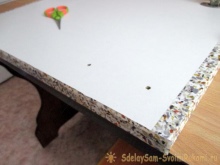
- If, after completing all the work, you notice that air bubbles remain on the base, it is best to carefully pierce them with a thin needle, squeeze out excess air just as carefully, and then carefully iron this area.


- It is recommended to heat the corners and joints with hot air using a regular hair dryer. Only after completing all the listed work, it will be possible to install the fittings in their original place. If the doors were processed from the headset, then they can be installed in their places.
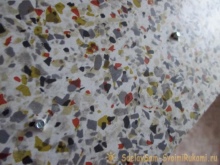















The comment was sent successfully.